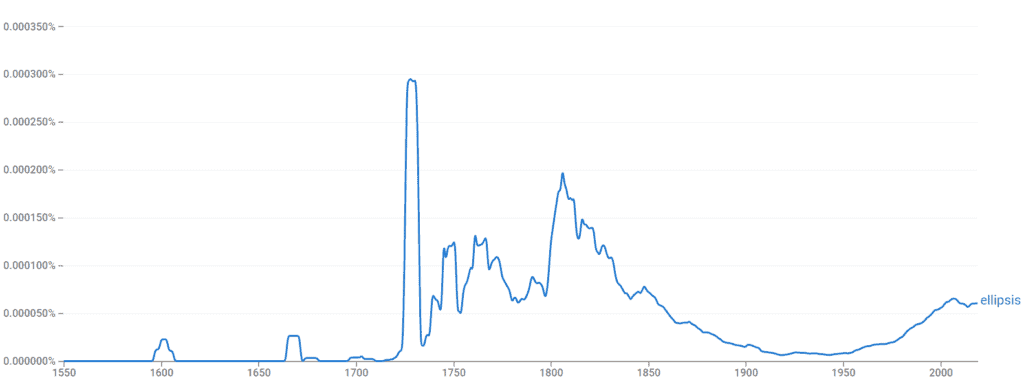The English language can be complex not only because of word choice and sentence structure but also because of its many punctuation marks. The ellipsis is a punctuation mark that can signify more than one thing or belong in more than one place, sounding confusing.
But using ellipses is easy! There are a few simple rules to keep in mind when using them. Look at our explanations below that offer plenty of examples to help you determine where to place them.
What is an Ellipsis?
An ellipsis is a punctuation mark represented by three dots to signify an omission or deletion of one or more words from a clause or sentence. It allows you to remove an unnecessary repetition of words to simplify and clarify information or to help create tone in a dialog.
Is an Ellipsis Always Three Dots?
Yes, the three dots that signify an ellipsis are standard and universal across all written languages.
Do I Capitalize After an Ellipsis?
You do not capitalize after an ellipsis unless it is the start of a new sentence or independent clause. It truly depends on how it is used within direct quotes or as part of a dialog.
Origins and How an Ellipsis is Used?

Ellipsis has roots in both Latin and Greek, meaning to “fall short, or leave out”. This definition has not changed through the centuries and was adapted into the English language during the late 1500s. Its plural use is ellipses.
It can be placed at the beginning, middle, or end of a sentence or quotation. When placed correctly, the omission of words the dots represent is usually implied by the context of the rest of the sentence.
Where to Place an Ellipsis?
The placement of an ellipsis is dependent on what you want to use it for. When used to specify important information and omit unnecessary or unrelated material, it helps direct a reader’s attention.
When used to express emotion or pause, its location may help provide characterization or give additional detail about a speaker within a dialog.
Take a look at these two rules to help you determine the best use of ellipses in your writing.
Ellipsis Rule #1
To share information using direct quotations, we can use an ellipsis at the beginning, middle, and end of quotes or between sentences. The placement is determined by what you feel is relevant to your reader and what information is redundant or irrelevant to the quote’s purpose.
This lets the reader know that the full quote is not being used. It also allows the reader to consider that the material could be used out of context.
For Example:
“General Secretary Gorbachev, if you seek peace… open this gate! Mr. Gorbachev, tear down this wall!” [President Reagan]
Ellipsis Rule #2
You can use ellipses within dialog to help express tone, suspense, pause in speech, hesitation, an unfinished thought, or other general characterizations of your characters. It can also suggest a wavering of thoughts or pausing within a sentence.
For Example:
- He looked at the picture, “is this…who I think it is?!” he exclaimed.
- She had to ask, “but what happens if he doesn’t respond…?”
- She hesitated, “I…I am very unsure…I don’t understand.”
Types of Ellipsis
There are various types of ellipses, many of which have labels, such as gapping, stripping, or sluicing. These are often grammatical and quite technical and don’t change how they are being used.
In fact, these terms often muddy the understanding of why they are being used in the first place, and it is best to approach their use with the rules provided above. An ellipsis will always be associated with the part of the sentence being left out, whether it be a series of words or something inferred.
Ellipsis Examples in Sentences
The following examples highlight how often ellipses are used in publications. This use almost always emphasizes that there is information missing and urges readers to visit a specific website to view the entire article or report.
This Morning … News9.com is proud to provide Oklahomans with timely and relevant news and information, sharing the stories, … [News 9]
… Boston breaking news, Massachusetts news and information from the Boston Herald. [Boston Herald]
8 Michigan hospitals, hundreds of health care sites to change names in major rebranding. Fidelity will soon allow investors to add bitcoin to 401(k) … [Detroit Free Press]
Denver, Colorado — The Mile High City — is where urban sophistication meets outdoor adventure …1575 California St., Denver, CO 80202. [Colorado.com]
Jake Oettinger isn’t new to big stages, and the Stars goalie is ready … [Dallas News]
Let’s Review
An ellipsis is a punctuation mark placed at the beginning, middle, or end of a sentence. It is used to designate missing information or highlight relevant information and reduce redundancy. It also can be used in dialog to express emotion or hesitancy. It is always represented by three dots.
